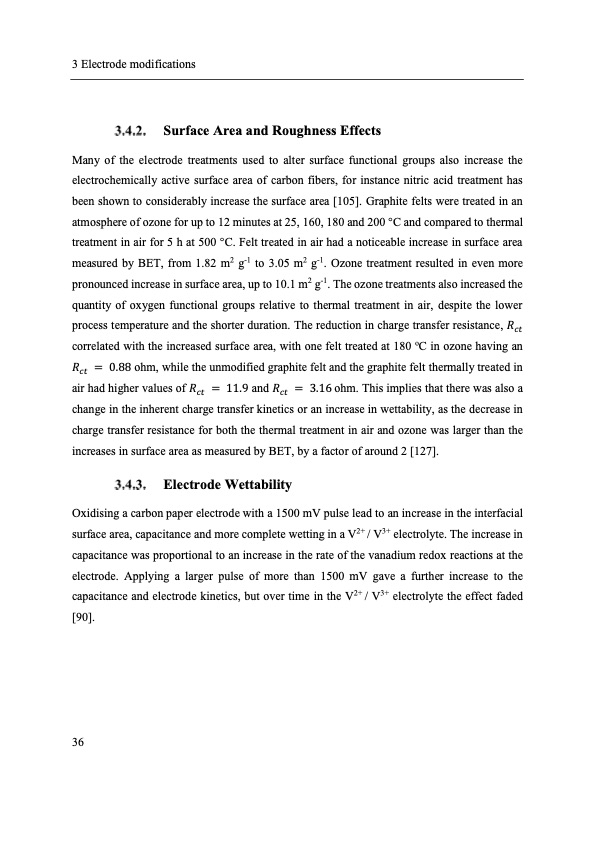
PDF Publication Title:
Text from PDF Page: 048
3 Electrode modifications Surface Area and Roughness Effects Many of the electrode treatments used to alter surface functional groups also increase the electrochemically active surface area of carbon fibers, for instance nitric acid treatment has been shown to considerably increase the surface area [105]. Graphite felts were treated in an atmosphere of ozone for up to 12 minutes at 25, 160, 180 and 200 °C and compared to thermal treatment in air for 5 h at 500 °C. Felt treated in air had a noticeable increase in surface area measured by BET, from 1.82 m2 g-1 to 3.05 m2 g-1. Ozone treatment resulted in even more pronounced increase in surface area, up to 10.1 m2 g-1. The ozone treatments also increased the quantity of oxygen functional groups relative to thermal treatment in air, despite the lower process temperature and the shorter duration. The reduction in charge transfer resistance, 𝑅𝑐𝑡 correlated with the increased surface area, with one felt treated at 180 oC in ozone having an 𝑅𝑐𝑡 = 0.88 ohm, while the unmodified graphite felt and the graphite felt thermally treated in air had higher values of 𝑅𝑐𝑡 = 11.9 and 𝑅𝑐𝑡 = 3.16 ohm. This implies that there was also a change in the inherent charge transfer kinetics or an increase in wettability, as the decrease in charge transfer resistance for both the thermal treatment in air and ozone was larger than the increases in surface area as measured by BET, by a factor of around 2 [127]. Electrode Wettability Oxidising a carbon paper electrode with a 1500 mV pulse lead to an increase in the interfacial surface area, capacitance and more complete wetting in a V2+ / V3+ electrolyte. The increase in capacitance was proportional to an increase in the rate of the vanadium redox reactions at the electrode. Applying a larger pulse of more than 1500 mV gave a further increase to the capacitance and electrode kinetics, but over time in the V2+ / V3+ electrolyte the effect faded [90]. 36PDF Image | Electron Transfer Kinetics in Redox Flow Batteries

PDF Search Title:
Electron Transfer Kinetics in Redox Flow BatteriesOriginal File Name Searched:
electron-transfer-flow-batteries-thesis.pdfDIY PDF Search: Google It | Yahoo | Bing
Salgenx Redox Flow Battery Technology: Salt water flow battery technology with low cost and great energy density that can be used for power storage and thermal storage. Let us de-risk your production using our license. Our aqueous flow battery is less cost than Tesla Megapack and available faster. Redox flow battery. No membrane needed like with Vanadium, or Bromine. Salgenx flow battery
| CONTACT TEL: 608-238-6001 Email: greg@salgenx.com | RSS | AMP |